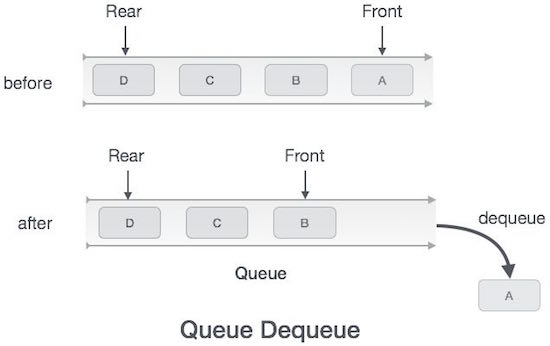Queue follows First-In-First-Out methodology, i.e., the data item stored first will be accessed first.
Queue Representation:
- Queue: the name of the array storing queue elements.
- Front: the index where the first element is stored in the array representing the queue.
- Rear: the index where the last element is stored in an array representing the queue
Basic Operations
Queue operations may involve initializing or defining the queue, utilizing it, and then completely erasing it from the memory. Here we shall try to understand the basic operations associated with queues −
enqueue() − add (store) an item to the queue.
dequeue() − remove (access) an item from the queue.
Few more functions are required to make the above-mentioned queue operation efficient. These are −
peek() − Gets the element at the front of the queue without removing it.
isfull() − Checks if the queue is full.
isempty() − Checks if the queue is empty.
In queue, we always dequeue (or access) data, pointed by front pointer and while enqueing (or storing) data in the queue we take help of rear pointer.
Let's first learn about supportive functions of a queue −
peek()
This function helps to see the data at the front of the queue. The algorithm of peek() function is as follows −
Algorithm
begin procedure peek return queue[front] end procedure
Implementation of peek() function in C programming language −
Example
int peek() { return queue[front]; }
isfull()
As we are using single dimension array to implement queue, we just check for the rear pointer to reach at MAXSIZE to determine that the queue is full. In case we maintain the queue in a circular linked-list, the algorithm will differ. Algorithm of isfull() function −
Algorithm
begin procedure isfull if rear equals to MAXSIZE return true else return false endif end procedure
Implementation of isfull() function in C programming language −
Example
bool isfull() { if(rear == MAXSIZE - 1) return true; else return false; }
isempty()
Algorithm of isempty() function −
Algorithm
begin procedure isempty if front is less than MIN OR front is greater than rear return true else return false endif end procedure
If the value of front is less than MIN or 0, it tells that the queue is not yet initialized, hence empty.
Here's the C programming code −
Example
bool isempty() { if(front < 0 || front > rear) return true; else return false; }
Enqueue Operation
Queues maintain two data pointers, front and rear. Therefore, its operations are comparatively difficult to implement than that of stacks.
The following steps should be taken to enqueue (insert) data into a queue −
Step 1 − Check if the queue is full.
Step 2 − If the queue is full, produce overflow error and exit.
Step 3 − If the queue is not full, increment rear pointer to point the next empty space.
Step 4 − Add data element to the queue location, where the rear is pointing.
Step 5 − return success.
Sometimes, we also check to see if a queue is initialized or not, to handle any unforeseen situations.
Algorithm for enqueue operation
procedure enqueue(data) if queue is full return overflow endif rear ← rear + 1 queue[rear] ← data return true end procedure
Dequeue Operation
Accessing data from the queue is a process of two tasks − access the data where front is pointing and remove the data after access. The following steps are taken to perform dequeue operation −
Step 1 − Check if the queue is empty.
Step 2 − If the queue is empty, produce underflow error and exit.
Step 3 − If the queue is not empty, access the data where front is pointing.
Step 4 − Increment front pointer to point to the next available data element.
Step 5 − Return success.

Algorithm for dequeue operation
procedure dequeue if queue is empty return underflow end if data = queue[front] front ← front + 1 return true end procedure
- Job scheduling tasks of CPU.
- Printer’s Buffer to store printing commands initiated by a user.
- Input commands sent to CPU by devices like Keyboard and Mouse.
- Document downloading from internet.
- User Requests for call center services.
- Order Queue for Online Food Delivery Chains.
- Online Cab Booking applications.
Characteristics of Queue:
- Queue can handle multiple data.
- We can access both ends.
- They are fast and flexible.









0 Comments